HART Majors and Minors Honored at Graduation Reception
Betsey Robinson, associate professor and acting chair of Vanderbilt’s History of Art department, and HART faculty and staff honored our majors and minors and their families at the department’s annual reception for graduating seniors in the atrium of Cohen Memorial Hall. Following Robinson’s warm welcome and introduction of the faculty and staff, awards were presented and outstanding students recognized for their accomplishments.
 This year the Cooley Prize for the highest grade point average in the history of art department was shared by four students. Graduating summa cum laude with a 4.0 GPA were Elizabeth Cynthia Emoki Horner (history of art and political science), Katherine Lynn Murphy (history of art and human & organizational development), Kathryn Sarah Roach (history of art and elementary education), and Isabelle Sophia Sagraves (history of art and English).
This year the Cooley Prize for the highest grade point average in the history of art department was shared by four students. Graduating summa cum laude with a 4.0 GPA were Elizabeth Cynthia Emoki Horner (history of art and political science), Katherine Lynn Murphy (history of art and human & organizational development), Kathryn Sarah Roach (history of art and elementary education), and Isabelle Sophia Sagraves (history of art and English).
Elizabeth Horner graduated summa cum laude with highest honors from the History of Art Senior Honors Program. Horner’s honors thesis was entitled “Art in War: The Legal Implications of Looting, Repatriation, and Restitution in World War II,” and her faculty advisor was Christopher Johns, Norman L. and Roselea J. Goldberg Professor of History of Art.
 Lillian Claire Boyle, BA’18, is the department’s first student to complete the 4+1 program, thereby earning the master of arts degree. Boyle’s research focused on museums (MOMA, among others) and their efforts to become more inclusive. She worked with Leonard Folgarait, Distinguished Professor of History of Art, and recently returned from Cuba, having completed an independent study with Maria Magdalena Campos-Pons, Cornelius Vanderbilt Chair of Fine Arts and professor of art.
Lillian Claire Boyle, BA’18, is the department’s first student to complete the 4+1 program, thereby earning the master of arts degree. Boyle’s research focused on museums (MOMA, among others) and their efforts to become more inclusive. She worked with Leonard Folgarait, Distinguished Professor of History of Art, and recently returned from Cuba, having completed an independent study with Maria Magdalena Campos-Pons, Cornelius Vanderbilt Chair of Fine Arts and professor of art.
Boyle also was a 2018-2019 Downing Award recipient as were Daniel Freedland (history of art and human & organizational development and economics), Maris Paden (history of art and medicine, health & society), Elizabeth Horner (history of art and political science), and Janna Adelstein (history of art and history and political science). The department awards these Downing grants for travel to exhibitions and research centers to supplement academic instruction for graduate students and HART majors who are enrolled in the Honors Program, in advanced seminars, or in upper-level “W” (writing) courses.
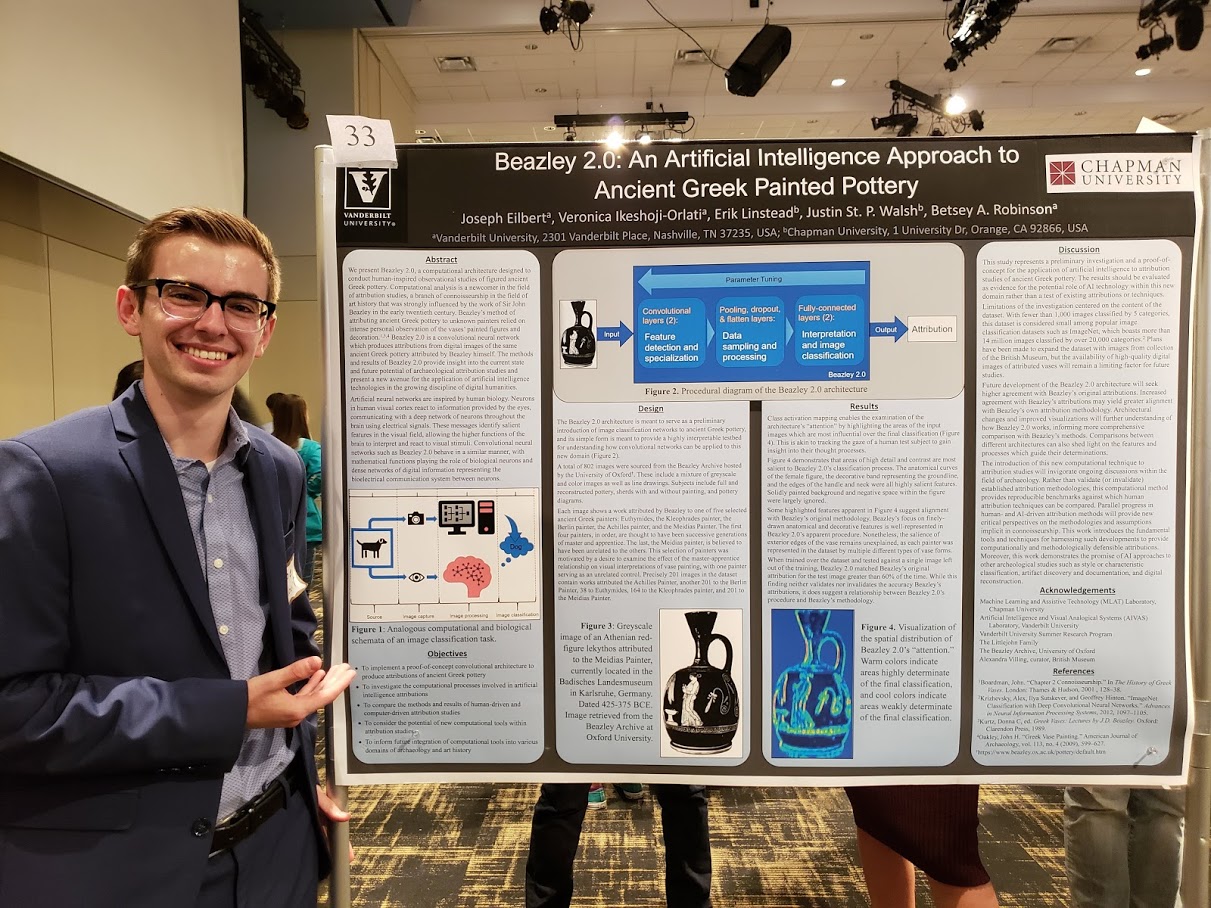 Joe Eilbert (history of art and physics) was recognized for his exceptional poster and presentation at the annual Vanderbilt Undergraduate Research Fair. Eilbert presented Beazley 2.0: An Artificial Intelligence Approach to Ancient Greek Painted Pottery. Betsey Robinson was his faculty mentor, and Eilbert presented his work at the 120th annual meeting of the Archaeological Institute of America (AIA) held this year in San Diego.
Joe Eilbert (history of art and physics) was recognized for his exceptional poster and presentation at the annual Vanderbilt Undergraduate Research Fair. Eilbert presented Beazley 2.0: An Artificial Intelligence Approach to Ancient Greek Painted Pottery. Betsey Robinson was his faculty mentor, and Eilbert presented his work at the 120th annual meeting of the Archaeological Institute of America (AIA) held this year in San Diego.
Held in conjunction with the celebration of our graduates was the opening reception for a student-curated exhibition entitled Refuting “Noble Savages:” Reflections of Nature in Ancient Mesoamerican Artifacts. On view through September 13, the exhibit features a collection of ancient Latin American artifacts curated by undergraduate students as part of a semester-long course (Exhibiting Historical Art—Daily Life in Mesoamerica) taught by Markus Eberl, associate professor of anthropology. The exhibition focuses on the connection between nature and culture among pre-Columbian Mesoamerican people (ca. 500 to 1500 CE), the artifacts on view elucidating their daily life and beliefs.
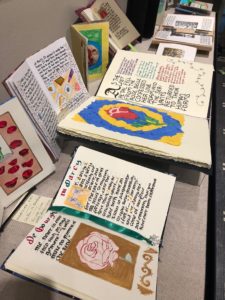 Another exhibit on view in the display cases of the Cohen atrium are the handmade books created and decorated by the students of Elizabeth Moodey, associate professor of history of art, for her HART 2288 course, Art of the Book.
Another exhibit on view in the display cases of the Cohen atrium are the handmade books created and decorated by the students of Elizabeth Moodey, associate professor of history of art, for her HART 2288 course, Art of the Book.
“Illuminated manuscript (literally “handwritten”) books are arguably the most characteristic objects of the European middle ages, but contemporary artists have also responded to the challenge of making a book by hand,” said Moodey. “Inspired by those traditions, each of the students chose a favorite text and acted as both patron and artisan for the books on display.”
Earlier in the day, the Class of 2019 had attended the Senior Day address of Venus Williams, tennis champion, entrepreneur and equal rights advocate, who shared with the graduates her number one lesson: “Help others. You have to make life bigger than you.”
Posted by vrcvanderbilt on June 4, 2019 in Events, Fine Arts Gallery, HART, News, Student/Alumni, Vanderbilt University, VRC
Kevin Murphy and Rebecca VanDiver Attend “Worlds of Print” Symposium
 Kevin Murphy, professor of history of art and department chair, and Rebecca VanDiver, assistant professor of African American art, recently participated in a symposium addressing the theme The Worlds of Print. Held at the University of California, Santa Barbara, the joint Vanderbilt-UCSB symposium was the culmination of a year-long Robert Penn Warren Center for the Humanities seminar organized by Murphy and Mark Hosford, associate professor of art and department chair. VanDiver was among the Warren Center Fellows participating in the interdisciplinary faculty seminar entitled The World of Print(s): Multiples and Meanings in Early Modern Europe and North America.
Kevin Murphy, professor of history of art and department chair, and Rebecca VanDiver, assistant professor of African American art, recently participated in a symposium addressing the theme The Worlds of Print. Held at the University of California, Santa Barbara, the joint Vanderbilt-UCSB symposium was the culmination of a year-long Robert Penn Warren Center for the Humanities seminar organized by Murphy and Mark Hosford, associate professor of art and department chair. VanDiver was among the Warren Center Fellows participating in the interdisciplinary faculty seminar entitled The World of Print(s): Multiples and Meanings in Early Modern Europe and North America.
On the panel entitled “Print as Reuse,” Murphy presented a paper on “The Material Life of Ephemeral Print.” Under the panel heading “Print as Pedagogy, Appropriation, and Protest,” VanDiver’s paper was entitled “Papers of Protest: Print in the Civil Rights Movement.”
 Visiting Warren Center scholar Patricia Fumerton, professor of English at UCSB, organized the symposium to generate conversation between participants in the Warren Center seminar and scholars of early modern print culture at UCSB. Participants attended a two-part print workshop on composing and setting montage; and printing montage. The group discussed each other’s work and collaborated on a print combining text and images selected by all the symposium participants.
Visiting Warren Center scholar Patricia Fumerton, professor of English at UCSB, organized the symposium to generate conversation between participants in the Warren Center seminar and scholars of early modern print culture at UCSB. Participants attended a two-part print workshop on composing and setting montage; and printing montage. The group discussed each other’s work and collaborated on a print combining text and images selected by all the symposium participants.
Rebecca VanDiver receives instruction in the UCSB Makers’ Lab on setting moveable type (above); VanDiver prints on a traditional manual press at USCB, coached by Patricia Fumerton, who was a 2018-19 visiting fellow at the Robert Penn Warren Center for the Humanities (below).
Posted by vrcvanderbilt on May 16, 2019 in Conferences, Events, HART, News, Vanderbilt University, VRC
Department to Celebrate HART Graduates at Reception and Awards Ceremony on May 9
 History of Art majors and minors and their families and friends are invited to attend the department’s reception and awards ceremony for our graduating seniors on Thursday, May 9, from 2 to 4 pm. The event will be held in the atrium of Cohen Memorial Hall on the Peabody campus, and awards will be presented at 2:30 pm.
History of Art majors and minors and their families and friends are invited to attend the department’s reception and awards ceremony for our graduating seniors on Thursday, May 9, from 2 to 4 pm. The event will be held in the atrium of Cohen Memorial Hall on the Peabody campus, and awards will be presented at 2:30 pm.
Graduates and their families also are invited to view the current exhibits in the Vanderbilt Fine Arts Gallery near the atrium from noon to 4:00 pm as well as in the display cases in the atrium itself. Closed on Commencement Day (Friday, May 10), the gallery will be open on Saturday, May 11, from 1 to 5 pm.
On view in the Fine Arts Gallery now through September 13, Refuting “Noble Savages”: Reflections of Nature in Ancient Mesoamerican Artifacts features a collection of ancient Latin American artifacts curated by undergraduate students as part of a semester-long course taught by Markus Eberl, associate professor of anthropology. The exhibition focuses on the connection between nature and culture among Pre-Columbian Mesoamerican people (ca. 500 to 1500 CE). The artifacts on view elucidate their daily life and beliefs.
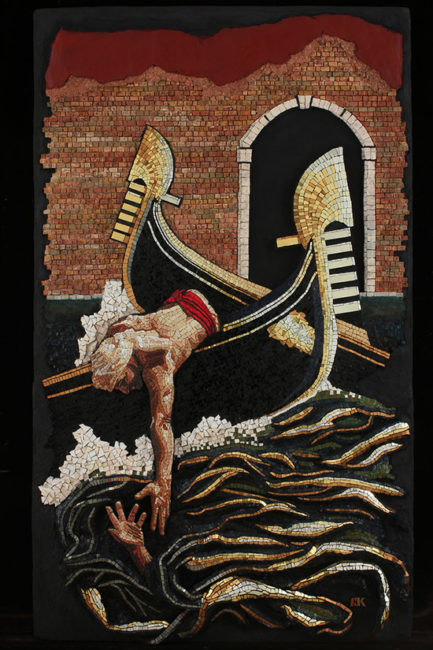 Embodied: Mosaic Arts International 2019 Invitational, on view in the gallery through May 25, features figurative works by five renowned mosaic artists working today: Lilian Broca (Canada), Shug Jones (United States), Michael Kruzich (United States), Atsuko Laskaris (Japan), and Carol Shelkin (United States). The contemporary mosaics attempt to capture the personal histories, preserved memories, and emotional occurrences of everyday life. Through meticulous manipulations of glass, stone and ceramic, these detailed works achieve a dynamic range of color, texture and reflectivity. Their durable materials and methods do not stray far from those of antiquity. Neither do their stories: Scenes presented in the mosaics share timeless themes of love and family, conflict and war, spirituality and society.
Embodied: Mosaic Arts International 2019 Invitational, on view in the gallery through May 25, features figurative works by five renowned mosaic artists working today: Lilian Broca (Canada), Shug Jones (United States), Michael Kruzich (United States), Atsuko Laskaris (Japan), and Carol Shelkin (United States). The contemporary mosaics attempt to capture the personal histories, preserved memories, and emotional occurrences of everyday life. Through meticulous manipulations of glass, stone and ceramic, these detailed works achieve a dynamic range of color, texture and reflectivity. Their durable materials and methods do not stray far from those of antiquity. Neither do their stories: Scenes presented in the mosaics share timeless themes of love and family, conflict and war, spirituality and society.
Illuminated manuscript (literally “hand written”) books are arguably the most characteristic objects of the European middle ages, but contemporary artists have also responded to the challenge of making a book by hand. Inspired by those traditions, each of the students of HART 2288, Art of the Book, taught by Elizabeth Moodey, associate professor of history of art, chose a favorite text and acted as both patron and artisan for the books on view in one of the display cases in the atrium.
The Fine Arts Gallery is located in Cohen Memorial Hall at 1220 21st Avenue South, on the western edge of the Peabody College campus. Parking is available anywhere in Lot 95 on the Peabody campus, accessible from 21st Avenue South.
Gallery hours for the summer (now through August) are Tuesday-Friday, noon to 4 pm; and Saturday, 1-5 pm. The gallery will be closed on Sundays and Mondays during the summer.
*Cohen Memorial Hall, floor detail; Michael Kruzich (American, b. 1964). Refuge, 2017. Stone, Italian smalti, and gold. 60 x 36 inches.
Posted by vrcvanderbilt on May 7, 2019 in Events, Fine Arts Gallery, HART, News, Student/Alumni, Vanderbilt University, VRC
Kevin Murphy to Lecture at University of Sydney School of Architecture, Design & Planning
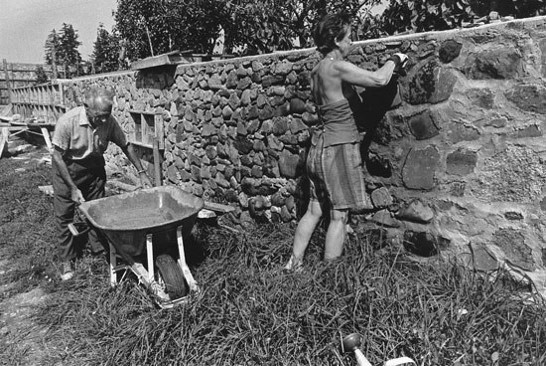 During the early to mid-twentieth century in the United States, self-building was promoted as a solution to housing shortages, but more importantly, as a means of bringing amateur builders into meaningful contact with their materials, with nature. Kevin Murphy, chair and professor of history of art, will address “Certain Rocks [are] Old Friends: Rhetorics of Self-Building in 20th-century America” in an April 30 lecture at the University of Sydney School of Architecture, Design & Planning, Darlington, Australia.
During the early to mid-twentieth century in the United States, self-building was promoted as a solution to housing shortages, but more importantly, as a means of bringing amateur builders into meaningful contact with their materials, with nature. Kevin Murphy, chair and professor of history of art, will address “Certain Rocks [are] Old Friends: Rhetorics of Self-Building in 20th-century America” in an April 30 lecture at the University of Sydney School of Architecture, Design & Planning, Darlington, Australia.
Murphy’s talk will focus on the “Flagg method” of stone and concrete construction, developed by skyscraper architect and advocate Ernest Flagg from the 1920s on. His followers, especially postwar “back-to-the-land” gurus Helen and Scott Nearing, drew on the rhetoric of Frank Lloyd Wright and other advocates for “organic” architecture to portray self-built masonry buildings as ethically necessary.
Murphy is the author of numerous books and articles on modern European and American architecture, most recently Skyscraper Gothic: Medieval Forms and Modernist Buildings (University of Virginia Press, 2017), co-edited with Lisa Reilly.
Posted by vrcvanderbilt on April 29, 2019 in Events, HART, Lectures, News, Vanderbilt University, VRC
Doughnut Days Held April 24 and 29 in Cohen 134
The Visual Resources Center (VRC) invites students, faculty, and staff to join us for coffee and doughnuts in Cohen 134 on Wednesday, April 24, and Monday, April 29. Coffee, tea, juices and light snacks will be available Monday through Friday during final exams (April 24-May 2).
Pour yourself a cup and dash to class or stay for a while and review images streaming across the big screen at the end of our large study table or simply sit down and take some time to relax and enjoy a cup of java or tea.
Posted by vrcvanderbilt on April 22, 2019 in Events, HART, News, Student/Alumni, Vanderbilt University, VRC
Kevin Murphy Interviewed on CBS and Other News Outlets About Notre Dame Cathedral
Kevin Murphy, professor of history of art, was among the art historians worldwide who watched in disbelief as international news outlets broadcast live images of the massive fire that ravaged the iconic Notre Dame Cathedral in central Paris on Monday, April 15. Murphy, an architectural historian, was interviewed that afternoon and the days following by several news anchors and journalists, beginning with a Monday evening interview on CBS News with Elaine Quijano under the heading “Massive Fire Burning Through Notre Dame Cathedral in Paris.”
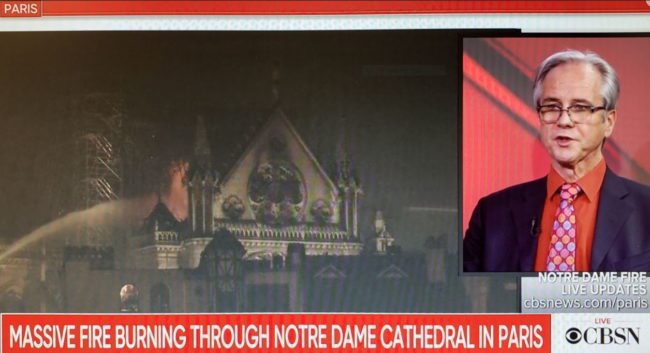 Murphy discussed the architecture and history of the cathedral as “an iconic monument of the Gothic style,” which had survived more than eight centuries and several wars, not to mention its profound symbolic value. As the week progressed, subsequent interviews with Murphy focused on the restoration and rebuilding of Notre Dame Cathedral and the immense challenges of such an undertaking..
Murphy discussed the architecture and history of the cathedral as “an iconic monument of the Gothic style,” which had survived more than eight centuries and several wars, not to mention its profound symbolic value. As the week progressed, subsequent interviews with Murphy focused on the restoration and rebuilding of Notre Dame Cathedral and the immense challenges of such an undertaking..
Is it possible to rebuild Notre Dame Cathedral after such a devastating fire? Such was the focus of Murphy’s interview with Tanya Rivera on CBSN at the top of the program on Tuesday, April 16, at 1 pm. That same day the Rick Gibbons Show (1310 News) in Ottawa featured an interview with Murphy during the second hour of the program.
Richard Lough included Murphy’s quote in this Reuters piece, “Old financing dispute hangs over Notre-Dame blaze donations,” published on April 16. “There was a continual cry for funds (in the 19th century) because the needs were so great for a building of that size. Necessarily it required enormous expenditures of money just to maintain it,” said Murphy.
Designing the rebuild will see two competing forces run up against each other, he said. “Imperative one is to preserve the building as an icon of French architecture, and the other is to make it serviceable for its purposes as a place of worship.”
Emily Tamkin published her article on April 16 in the Washington Post, “What cathedrals are vulnerable to burning quickly and take a long time to rebuild,” in which she quoted Murphy. “I think what people should understand is the ingenious approach by medieval builders,” he said. “The technology of the building is not, of course, technology that we use anymore. In some cases, the actual technology has been under debate for centuries. Trying to understand how it was built is not straightforward.”
Kelly McLaughlin at INSIDER published her piece on Wednesday, April 17, “Emmanuel Macron announced plans to rebuild Notre-Dame in 5 years, but it could take much longer,” and frequently quoted Murphy. Lori Hinnant interviewed him for an AP (Associated Press) story that ran on April 17: “66 minutes: The frantic race to save Notre Dame.” That AP article has been picked up by hundreds of outlets across the country, including TIME Magazine (online), under the title “Paris Fire Fighters Only Had 66 Minutes to Save Precious Notre Dame Artifacts.”
Coverage on CNBC regarding the restoration of the cathedral aired on April 17. Murphy was quoted in this piece, “Restoration of the Notre Dame Cathedral could take years and cost upward of $1 billion, experts say,” which has been published in 90 or so additional publications. “The timber that was used [in the roof] was cut down hundreds of years ago from forests that don’t exist anymore in the quantity they would need for that huge of a structure,” Murphy noted. “It would be difficult if not impossible to obtain timber on the scale that was in the roof.”
Murphy taped an April 17 interview with the BBC from Oxford and another with the radio station WTOP in DC, which aired that same day.
Blair Kamin interviewed Murphy for his April 18 article in the Chicago Tribune entitled “The French announce a design contest for Notre Dame’s destroyed spire: Inspired idea or publicity stunt?” Viollet-le-Duc’s Notre Dame spire, Murphy told Kamin, replaced one that was in bad condition and was taken down in the 1780s. With the new spire, Murphy said, Viollet-le-Duc sought to achieve a sky-piercing exterior expression of the awe-inspiring Gothic verticality that may not have been achievable when the building was constructed in the 12th and 13th centuries. “It was about height and lightness, also the position of the cathedral in the city, marking that important institution,” Murphy said.
What about the possibility that Viollet-le-Duc’s spire might be replaced with a different design? posed Kamin. “I’m attached to his work,” Murphy replied. On the other hand, “the building as it exists has a very long history. There’s nothing pure about it. It’s been altered and restored over the course of many centuries…It might be interesting to see a proposal for a spire that was compatible with the building but at the same time spoke to our own time the way Viollet-le-Duc’s did.”
Then, Murphy added, “It could be horrible.” The stakes are indeed high.
*The Department of History of Art wishes to thank Spencer Turney, Media Relations and Strategic Communications Specialist, and Ann Marie Deer Owens, Senior Public Affairs Officer, both with Vanderbilt News and Communications, for their role in scheduling Kevin Murphy’s interviews with the news media and providing us with the links.
Posted by vrcvanderbilt on April 19, 2019 in HART, News, Vanderbilt University, VRC
Rebecca VanDiver Awarded 2019 NEH Summer Stipend
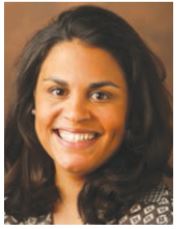 The National Endowment for the Humanities has awarded Rebecca VanDiver, assistant professor of African American art, a 2019 Summer Stipend for $6,000. VanDiver is in the early stages of research for her second book manuscript on twentieth-century African American art that addresses the notion of impermanence. Her working title is States of Emergency: Politics of Ephemerality in African-American Art Practices, 1965–2015.
The National Endowment for the Humanities has awarded Rebecca VanDiver, assistant professor of African American art, a 2019 Summer Stipend for $6,000. VanDiver is in the early stages of research for her second book manuscript on twentieth-century African American art that addresses the notion of impermanence. Her working title is States of Emergency: Politics of Ephemerality in African-American Art Practices, 1965–2015.
“In this new project, I will examine the ways in which African American artists working during the past 50 years have engaged with ideas of ephemerality, producing temporary materials like prints and posters as well as larger-scale projects, like site-specific community murals,” VanDiver said. “An example of that would be the Wall of Respect that existed on Chicago’s South Side from 1967 to 1981.”
She will use the NEH funding to conduct primary source research for the first chapter, which will focus on prints and posters made in connection with the 1960s civil rights movement and the early black feminist movement.
“For this research, I am using a somewhat broader definition of the word ephemera,” VanDiver said. “While the word is traditionally defined as something fleeting and transitory, I am expanding the definition to include the news media as a vehicle for ephemerality.”
The latter half of her book will focus on how African American contemporary artists such as Kara Walker and Titus Kaphar have responded to the 24-hour news cycle by producing permanent works of art.
VanDiver, who came to Vanderbilt in the fall of 2013, teaches courses on modern/contemporary African American and African art and visual culture. Her research, centered on 20th-century black women artists, African American artistic engagements with Africa, and the politics of exhibition and display, has appeared in American Art, Archives of American Art Journal, Space and Culture, Callaloo, and Transition. The Pennsylvania State University Press is publishing her book-length manuscript on the artist Loïs Mailou Jones under the title Negotiating Traditions: Loïs Mailou Jones and the Composite Aesthetics of Blackness.
The NEH Summer Stipends program is highly competitive. The awards to VanDiver and another Vanderbilt professor, Phillip Lieberman, assistant professor of Jewish studies, classical and Mediterranean studies, religious studies and law, were the only ones in the state of Tennessee this year.
*See Ann Marie Deer Owens’ article (May 13, 2019) in “Research News @Vanderbilt”
Posted by vrcvanderbilt on April 17, 2019 in HART, News, Vanderbilt University, VRC
Yvonne Boyer to Highlight Floral Selections from the Library’s French Collections
 From romance to revolution, flowers flourish as an important part of French culture. The flower is a significant symbol of France, as its cultivation and the delights of an aromatic bouquet can be found throughout literature. During the spring semester, it is the season to cultivate the Library collections for their significant blossoms–a rite of spring.
From romance to revolution, flowers flourish as an important part of French culture. The flower is a significant symbol of France, as its cultivation and the delights of an aromatic bouquet can be found throughout literature. During the spring semester, it is the season to cultivate the Library collections for their significant blossoms–a rite of spring.
On Wednesday, April 10, Yvonne Boyer, Librarian for Art, History of Art, French & Italian, and the WT Bandy Center for Baudelaire & Modern French Studies, will discuss floral selections from the French collections, from poetry to artists’ books, specifically the works of the influential nineteenth-century illustrator, J.J. Grandville. Boyer’s talk, entitled Les Fleurs du Printemps: Selections from the French Collections, will begin at 11:10am in the Special Collections Reading Room on the second floor of the Central and Divinity Libraries building.
*llustration from J.J. Grandville’s Les fleurs animées (1847), courtesy of the Special Collections Library, Vanderbilt University
Posted by vrcvanderbilt on April 5, 2019 in Events, HART, Lectures, News, Vanderbilt University, VRC
Hazel Dodge to Deliver AIA/Kress Alumni Lecture on April 9
A visit to Roman sites in the Mediterranean is memorable not only because of the scale of the buildings and their survival, but also because of the noticeable use of a wide range of decorative 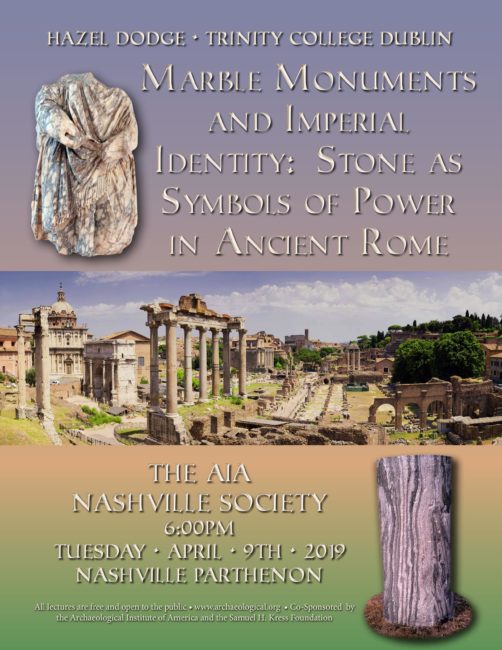 stones, both white and colored. On Tuesday, April 9, at 6 pm in the Nashville Parthenon, Hazel Dodge will deliver an AIA/Kress Alumni Lecture entitled “Marble Monuments and Imperial Identity: Stone as Symbols of Power in Ancient Rome.” Dodge is the Louis Claude Purser Senior Lecturer in Classical Archaeology with Trinity College, Dublin.
stones, both white and colored. On Tuesday, April 9, at 6 pm in the Nashville Parthenon, Hazel Dodge will deliver an AIA/Kress Alumni Lecture entitled “Marble Monuments and Imperial Identity: Stone as Symbols of Power in Ancient Rome.” Dodge is the Louis Claude Purser Senior Lecturer in Classical Archaeology with Trinity College, Dublin.
The Romans employed these decorative stones in both public and private buildings on an unprecedented scale, being prepared to quarry them in huge quantities and transport them the length of the Mediterranean and beyond. This practice had its origins in the capital of the empire, where initially these stones were brought back to Rome as spoils of war and used by triumphant generals to advertise military victories and to enhance their political position. Later, the emperors’ building projects transformed this exploitation to a level of activity never seen before or since.
In her lecture Dodge will examine not only the technology involved in the quarrying and transport of these resources, but also the ideologies of imperial power and the role these stones played in transforming not only the city of Rome but also the other cities of the Roman Empire.
Dodge focuses her research on construction techniques and the building technology of the Roman Empire, especially in the eastern Mediterranean. She is interested in the quarrying, transport, distribution and use of decorative stones in the Roman world; ancient spectacle and the buildings which were developed to accommodate the different types of entertainment; and urbanization in the ancient world, particularly the development of the City of Rome.
Free and open to the public, the lecture is cosponsored by the Nashville Society of the Archaeological Institute of America (AIA) and the Samuel H. Kress Foundation. Those who plan to attend the lecture are encouraged to call the Nashville Parthenon at 615.862.8431 to reserve a seat. The Parthenon is located at 2500 West End Avenue in the Centennial Park.
Posted by vrcvanderbilt on April 4, 2019 in Events, HART, Lectures, News, Vanderbilt University, VRC
Renée Ater to Examine Monument to Nation’s Slave Past in April 11 Goldberg Lecture
Renée Ater, associate professor emerita, American Art, The University of Maryland, studies monuments to the nation’s slave past. In a research project funded by the Smithsonian Institution, National Endowment for the Humanities, and the Getty Research Institute, Ater is documenting twenty-five memorials and monuments to slavery and its victims in twenty-three states across the South, Midwest, and Northeast.
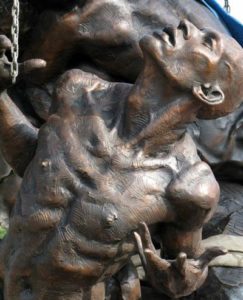 Ater will deliver the Norman L. and Roselea J. Goldberg Lecture on Thursday, April 11, at 4:10 pm in Cohen 203, with a reception to follow in the atrium. Her lecture, “Death, Remembrance, and the Slave Past,” is about a place of reckoning with the slave past, of erasure and discovery, of acknowledgement and reclamation.
Ater will deliver the Norman L. and Roselea J. Goldberg Lecture on Thursday, April 11, at 4:10 pm in Cohen 203, with a reception to follow in the atrium. Her lecture, “Death, Remembrance, and the Slave Past,” is about a place of reckoning with the slave past, of erasure and discovery, of acknowledgement and reclamation.
Dedicated in 2014 with an elaborate community celebration, the Contrabands and Freedmen Cemetery Memorial in Alexandria, Virginia, contains contemporary gravestones of unidentified adults and children, an open structure named the Place of Remembrance, and a monumental statue, Mario Chiodo’s Path of Thorns and Roses, a towering series of men and women cast in bronze.
During the American Civil War, the cemetery served as the burial place for more than 1,800 African Americans who fled to Alexandria from surrounding slave states to escape the horrors of bondage. After the war, it fell into disrepair, eventually displaced from city maps and forgotten, with a gas station built over the site in the 1950s. Rediscovered in the 1980s through a chance find in an archived newspaper, the cemetery became the focus of intense interest with archaeological excavations beginning in the late 1990s. The memorial marks the graves, commemorates the dead, and attempts to represent the anguish of the slave experience.
 Ater’s lecture investigates the recovery of the Contrabands and Freedmen Cemetery Memorial in the twenty-first century. Several ideas frame her talk: the cultural power of the dead body to do work in the present; the absence of a name connected to the dead body and the compulsion to name the deceased in order to anchor and memorialize the dead in the past, present, and future; a community’s desire to reckon with and monumentalize the slave past; and the dialectic between death and hope/freedom in visual and rhetorical forms.
Ater’s lecture investigates the recovery of the Contrabands and Freedmen Cemetery Memorial in the twenty-first century. Several ideas frame her talk: the cultural power of the dead body to do work in the present; the absence of a name connected to the dead body and the compulsion to name the deceased in order to anchor and memorialize the dead in the past, present, and future; a community’s desire to reckon with and monumentalize the slave past; and the dialectic between death and hope/freedom in visual and rhetorical forms.
Currently a senior fellow at the Smithsonian American Art Museum in Washington, DC, Ater is working on her digital project, Contemporary Monuments to the Slave Past: Race, Memorialization, Public Space, and Civic Engagement, and investigating how we visualize, interpret, and engage the slave past through contemporary monuments to slavery created for public spaces.
*Detail from Mario Chiodo’s Path of Thorns and Roses, bronze; and full view of the Contrabands and Freedmen Cemetery Memorial (2014), Alexandria, VA.
Posted by vrcvanderbilt on April 2, 2019 in Events, HART, Lectures, News, Vanderbilt University, VRC

©2024 Vanderbilt University ·
Site Development: University Web Communications